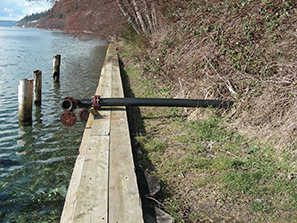 If you live at the top of a bluff, taking care of your water runoff is critical. Homeowners have caused landslides by directing water over bluffs. The routing of surface runoff to the beach in a tightline (a closed pipe) is standard practice in the Puget Sound region, although the degree to which it helps is highly site dependent. It is important to make sure that pollutants do not enter the tightline as they will be flushed directly into the water.
If you live at the top of a bluff, taking care of your water runoff is critical. Homeowners have caused landslides by directing water over bluffs. The routing of surface runoff to the beach in a tightline (a closed pipe) is standard practice in the Puget Sound region, although the degree to which it helps is highly site dependent. It is important to make sure that pollutants do not enter the tightline as they will be flushed directly into the water.
- Designing and constructing a tightline. If your groundwater and/or surface waters are tightlined to your beach, it is very important that these lines are properly designed, constructed, and maintained. The tightline pipe material has to be sufficiently strong to withstand the elements, anchored securely to the bluff, and not perforated. Water from a tightline should never be discharged at the top or middle of a slope.
- Choosing a discharge point location. Carefully consider the discharge point location for your tightline. An energy dispersion device or method should be used at the discharge point to prevent beach erosion.
- Checking tightlines regularly. Vegetation should not be allowed to cover the tightline, so you easily inspect the line to ensure that it remains securely fastened and that there are no leaks. If you find a maintenance problem, be sure to fix it immediately to ensure bank stability. Inspect your tightline and its discharge after a major storm. Tightlines can fail during large storm events, concentrating huge flows of water onto your bluff face. They can also be damaged by falling tree limbs, small landslides, and by heavy winds. They can be clogged by ice, debris, and animal nests, so you need to check regularly during the rainy season to verify that water runoff is actually exiting the lower end of the pipe. If there is a failure, severe erosion can occur over a very short period of time.
- Checking the regulations. Consult your county or city regarding current regulations and resources that can help with site assessment, design, and construction. Some tightline materials and installment methods may not be allowed in your area, so it is important to check before installing.